Stephen Roney's Blog, page 233
July 2, 2020
News of the Apocalypse
Apparently there will be a full moon this year on the night of July 4th, America’s big day. Oh, and a lunar eclipse.
Biden, apparently suffering from rapidly advancing senility, is far ahead in the polls.
Mobs are now tearing down statues of elk.
Meantime, China is experiencing a new outbreak of the coronavirus now in their capital; an emerging strain of influenza capable of a separate pandemic; historical flooding on the Yangtze River; hailstones the size of baseballs in Wuhan, the original site of the coronavirus outbreak, just downriver from the Three Gorges Dam, now in danger of bursting. A tornado was recently filmed (videoed?) on the outskirts of Beijing. And did I mention the knee-deep snow that in Western China on July 1st?
God is no longer being subtle about it.
'Od's Blog: Catholic and Clear Grit comments on the passing parade.
Published on July 02, 2020 15:44
July 1, 2020
The Spider and the Fly
A fascinating interview with Mary Margaret O’Hara, who has rightly been called a national treasure. I think if she walked into any psychiatrist’s office, she would be diagnosed as schizo-affective. She would certainly be considered psychotic. She reminds me of others I have known.
But that is not a helpful way to see it.
Listening to her, it ought to be clear that she is in contact with the spiritual world. It is obvious that she is highly intelligent, as psychotics usually are; her mind is working too quickly. She is seeing things the rest of us cannot see. Her consciousness is shamanic.
While most psychotics are silenced, either drugged or cowed into silence, O’Hara is able to channel her inspiration in her music.
Which is wonderful, and which I recommend, if you have not heard it.
She also radiates the moral purity, the sincerity, the lack of a filter or mask, and the vulnerability I have seen in others with such diagnoses. As well as the constant self-doubt of one who has been systematically abused or profoundly emotionally betrayed in childhood. Which is usually their story.
That is worth observing closely. But something else is worth observing, and is disturbing.
It is disturbing to watch the interaction with Jian Ghomeshi.
We know enough about Ghomeshi to know that, while his conduct may never have been criminal, he is a sexual predator and a narcissist. And he is charming her like a snake hypnotizing his prey. He is feigning understanding her in some special way, and feigning sympathizing with her entirely. She is not used to being able to have a serious conversation with someone. Most people just don’t want to talk about real things; they probably ignore most of what she says.
You can see she is drawn to him.
And he is, I fear, expressing covert malice by choosing to coax her into that particular duet: "Baby, It's Cold Outside," with its hint of less than fully-consensual sex.
It feels like the narcissist asserting his feelings of superiority and demanding dominance. And testing how much he can get away with before she realizes what is going on.
It is an illustration of how the abused remain eternally vulnerable to narcissistic predators. It is terrifying to think of how she might have been hurt if Ghomeshi drew her in.
'Od's Blog: Catholic and Clear Grit comments on the passing parade.
Published on July 01, 2020 14:50
June 30, 2020
The Story of Isaac
One of the most troubling passages in the Bible is the story of the binding of Isaac: Abraham setting off up Mount Moriah to sacrifice his son.
Traditionally, in Christianity, Abraham is portrayed here as passing a test of faith: obeying God’s command no matter what. This is because it is explained in this way, as evidence of Abraham’s great faith, in the New Testament: Hebrews 11: 17-19.
But this does not seem to make sense on its face. How, after all, did Abraham know it was God’s voice speaking to him? We are advised to “test the spirits,” and calling on him to do an immoral act should have been proof positive that the voice he heard was not God, but the Devil. God, being all-good, cannot command an immoral act.
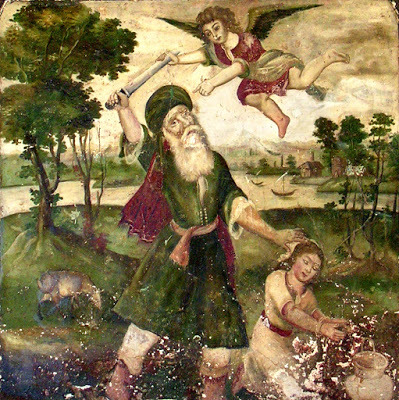
I, on a close reading, conclude that Abraham must have understood from the beginning that there was no chance Isaac was actually going to be sacrificed, that God had told him so. It was all done for show, in the context of a surrounding society that practiced child sacrifice, and would expect such a thing.
But then, the question arises; why is child sacrifice or infanticide so much a feature of so many cultures?
Jewish commentators find the passage similarly disturbing; and are less inclined than Christian commentators to give Abraham a pass.
Leonard Cohen wrote a song about it, “The Story of Isaac,” in which he accuses Abraham of simple malice towards his son:
A scheme is not a vision
And you never have been tempted
By a demon or a god.
In doing so, Cohen suggests that Abraham represents and is acting out an eternal urge: the parent’s feelings toward their child are always ambivalent. The child, after all represents the parent’s own mortality. The child will gather strength as the parent’s strength wanes, and one day will supplant them. The child looks like a dangerous rival. At least, to a narcissistic parent.
When it all comes down to dust
I will kill you if I must
I will help you if I can.
When it all comes down to dust
I will help you if I must
I will kill you if I can.
Cohen seems to see this in his own childhood. He makes Isaac nine years old—the same age he was when his father died. He speaks then from Isaac’s perspective. He explains, in an interview, that at that point in his own life it seemed to him that it was “either him or me.” If his father had not died, he would have.
This seems to say Cohen was abused in his early childhood. This might explain, in turn, his lifelong struggles with depression.
Cohen, writing the song during the Vietnam War, suggests such an impulse to kill the young may be behind the urge to war: the old men send off the young to die.
You who build these altars now
To sacrifice these children,
You must not do it anymore.
.. have mercy on this uniform,
Man of peace or man of war.
"It has fathers and sons in it and sacrifice and slaughter, and an extremely honest statement at the end. It does say something about fathers and sons and that curious place, generally over the slaughtering block where generations meet and have their intercourse. I think probably that I did feel [when I wrote it] that one of the reasons that we have wars was so the older men can kill off the younger ones, so there’s no competition for the women. Also, completely remove the competition in terms of their own institutional positions."Cohen’s take may shock, but is in fact confirmed by fairy tale after fairy tale: it is the underlying theme, for example, of Snow White, or Beauty and the Beast, or Cinderella, or Hansel and Gretel, or Rapunzel.
We pretend it is not there, we are in denial as a civilization, as we abort our young in vast numbers, but it is inevitably there.
'Od's Blog: Catholic and Clear Grit comments on the passing parade.
Published on June 30, 2020 13:33
June 29, 2020
More on Statue-Tipping and Bust Trusting
Image of unknown provenance forwarded by Diana RoneyThe statue hysteria continues. I learn of local initiatives to rename Winston Churchill Road and Dundas Street.
These examples show clearly enough how illegitimate the entire enterprise has been. Strike out the name of Winston Churchill? The man who, less than a century ago, saved civilization?
It seems to me conceptually impossible to pull down Churchill without, implicitly, endorsing Adolph Hitler and all the latter stood for. That is the necessary symbolism. Anything else about Churchill must pale in comparison. And those who want to do so, at some level, know this. At some level, they prefer Hitler.
Just as those who pulled down statues during the Cultural Revolution did so implicitly in support of Mao Zedong, a worse mass murderer than Hitler. Just as Winston Smith put inconvenient history down the memory hole. Pulling down the heroes of the past is, again symbolically, pulling down all restraints on behavior in the present.
And Dundas Street? That would, in the first place, be viciously destructive. Yonge-Dundas Square has become the symbolic heart of the city; it would be like, in New York, renaming Times Square, or, in London, Piccadilly Circus.
Henry Dundas was a leading Scottish abolitionist. I would assume this is why he was commemorated here, by Lord Simcoe, another passionate abolitionist. As a barrister, Dundas got slavery declared illegal in Scotland; his summation was historic, praised by Boswell and Johnson.
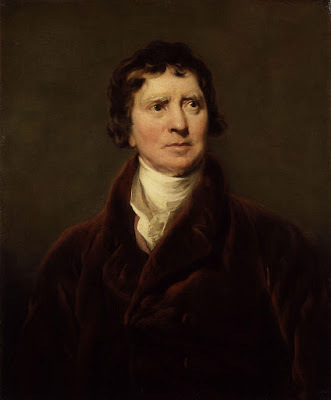 Henry Dundas, First Viscount Melville.
Henry Dundas, First Viscount Melville."As Christianity gained ground in different nations, slavery was abolished … I hope for the honour of Scotland, that the supreme court of this country would not be the only court that would give its sanction to so barbarous a claim.…. Human nature, my Lords, spurns at the thought of slavery among any part of our species.”
Then he shepherded legislation through the Commons to ban it throughout the British Empire.
It is hard to interpret removing his recognition as anything other than a tacit endorsement of slavery. The official alibi is that he sponsored an amendment to the anti-slavery bill to make its abolition “gradual.” This was transparently a strategic move: the bill had previously been soundly defeated without this amendment. By adding it, he got the bill through.
This is not worthy of our respect? It can only be attributed to envy. There is no other possible explanation. These men are to be brought down not because they did something wrong, but because they did something very right.
So what are we to do for our fellow citizens who say they are offended by having to see these statues?
I have often heard the suggestion in recent days that such controversial statues should be moved to museums, out of the public eye. This is not a practical solution; the statues are too large and too numerous to be exhibited in the typical existing. Realistically, if they are not simply to be mothballed, you’d have to build a lot of new, specially designed museum space.
Most of these statues were originally private donations to the public, financed by public subscription. If some of us want to be protected from them, then fairness and decency dictates at a minimum that such people should show respect for their fellow citizens, and for the generosity of the original donation, by funding the construction of some new museum space to exhibit them in a suitably dignified manner. And the cost of moving them.
I do not see anyone setting up such crowdfunding sites.
Someone suggests they be replaced with statues of Jesus. Surely we can all agree on Jesus as a good man? One would think so, but of course, the demand came only a few days ago to smash all images of Jesus.
Nor is the demand new. When it comes to the public square, it was where this all began. Years ago, the US Supreme Court ruled against displays of religion in the public space. On the perfectly spurious grounds of “separation of church and state,” a concept that appears nowhere in either the US or Canadian constitution, but was read in by the courts. Jesus was actually the first figure we tore down, as well as the ultimate target. Perhaps all else has followed.
Another suggestion often heard currently is “replaquing.” The government is supposed to put new plaques on such “controversial” statues to give a balanced view.
I doubt this idea is workable, and it is disturbing to begin with: it is the government telling us what to think. Those who, say, admire Columbus as a fellow Italian, will probably see such a plaque as a defacing of his monument. Those who think he was a monster will probably not be mollified by such a plaque, so long as the statue still stands—after all, a statue does not necessarily imply unqualified or even qualified support in the first place. Only that the figure is culturally or historically important, worth remembering.
There is a simpler solution, if those who dislike the statues were prepared to respect their neighbours. Simply let people develop enhanced reality apps keyed to all such monuments, locally or nationally, offering a choice of politically acceptable interpretations to interested onlookers. Those who are passionately opposed to Winston Churchill can happily point their smartphones at his effigy, and hear all about the horrible fellow he was. While those who cherish his memory can point their cell phones, and hear a selection of his great speeches.
 She
SheSomething like that has actually long been done with public monuments in Asia. For any given major cultural site, there seems to be a Buddhist interpretation, a Taoist interpretation, a Hindu interpretation, a Confucian interpretation, a Muslim interpretation, and/or a Christian interpretation. This foot print on a mountaintop was left by Adam; or it is Rama’s; or the Buddha’s. This figure is Kwan Yin, the goddess of Mercy; or it is the Bodhisattva Avalokiteshvara, or it is Mary, the mother of Jesus. As you prefer.
Civilized people do not tear down art. Civilized people do not tear down one another’s most precious memories.
'Od's Blog: Catholic and Clear Grit comments on the passing parade.
Published on June 29, 2020 16:23
Ozymandias
Here's my friend Jack Rigg reading the classic Shelley poem.
Your mileage may vary, as they say, but to my mind, nobody does a better job at a dramatic reading than Jack. It's a tricky thing to do: the dramatics makes you want to do one thing, and the rhythms of the poem make you want to do another. It's tough to strike the right balance.
Jack could do a master class.
'Od's Blog: Catholic and Clear Grit comments on the passing parade.
Published on June 29, 2020 15:30
June 28, 2020
Public Art
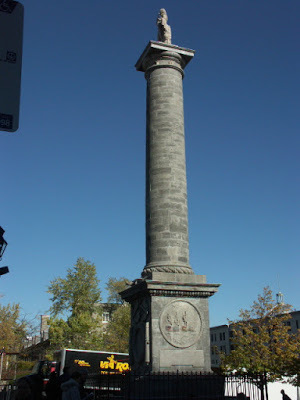 Nelson's Column, MonttrealOkay, people are saying they are offended by statues.
Nelson's Column, MonttrealOkay, people are saying they are offended by statues. The remedy is the same as with freedom of speech: if you disagree, put up your own statue. Just as, if you disagree, you do not try to silence the other, but counter his argument.
Like many other places in the former British Empire, Montreal has a Nelson’s Column, commemorating the great British admiral.
In Dublin, they blew theirs up, to express their distaste for English rule.
The Quebecois, surely, had more reason to feel offended, since, after all, it was France against which Nelson won his victories. But they hose the civilized Canadian way. Instead of tearing Nelson down, as they surely could have any time in the past hundred years, they put up another statue nearby, of Vauquelin, a French naval hero of the Seven Years’ War. Both ethnic groups get their heroes.

The Confederate statues, like them or not, are important memorials for some Americans of their history. If seeing them offends some, it is equally true that seeing them come down offends others. Mutual respect requires that they stay.
But by all means, all other groups ought to feel free to fund and erect their own public statues, then, of Malcolm X, or Martin Luther King, or John Brown, or Nat Turner, or Sitting Bull, or Pontiac, or, really, anyone else..
More public art is good. Less public art is bad. More free speech is good. Less free speech is bad.
This is not complicated.
'Od's Blog: Catholic and Clear Grit comments on the passing parade.
Published on June 28, 2020 14:02
The Inside Line on the US Presidential Election
Scott Adams has passed on an interesting theory: that since the advent of TV, the winner of the US Presidential election has always been the candidate who looks as though they could win in a fistfight or brawl. I had noticed before that the taller candidate usually wins. People perhaps instinctively look to the physically stronger candidate as the natural leader, as he would be in a wolf pack.
Trump-Clinton – Trump. This theory suggests that female leaders are at a permanent disadvantage.
Obama-Romney – Adams sees this as a tossup. But I think Obama would win on physical dexterity. He had and has a bit of a reputation as a basketball player. Romney moves stiffly.
Obama-McCain – Obama. McCain has to lose on the grounds of age and disability.
Kerry-Bush – I’m not sure it would have been Bush in a fair fight, but he gave the impression of being more physical. Kerry did not have an athletic build.
Gore-Bush – also hard to call. And so was the election. Gore looks bigger. Bush might have the edge since, at one of the debates, Gore tried to crowd him physically, and Bush did not budge. Making him look like the tougher candidate. Gore moved stiffly.
Clinton-Dole – Clinton, easily, on age alone, let alone Dole’s disability, and Clinton’s physical agility.
Clinton-Bush – Clinton, again on age alone.
Bush-Dukakis – Dukakis was short and looked silly in a tank. Bush.
Reagan-Mondale – Surely should have been Mondale, based on age. But Reagan played a tough guy in the movies; and he may still have projected strength, thanks to his acting ability.
Reagan-Carter – Carter was short; visually a pipsqueak. Reagan.
Carter-Ford – should have been Ford, by this metric. Ford was a college athlete. Carter was Carter. But the critical factor might have been that Ford moved clumsily. The general impression might have been that he was too stiff and had slow reflexes—Obama’s probable advantage over Romney. He would have been outboxed.
Nixon-McGovern – McGovern was lanky, an unathletic build. And had a voice similar to Liberace’s.
Nixon-Humphrey – Nixon. Humphrey was overweight.
Johnson-Goldwater – at first glance, should have been Goldwater. Johnson was a bit overweight. But he was physically huge, and did give an impression of physical strength and toughness.
Kennedy-Nixon – Kennedy wins on vim and vigor.
If the metric is good, Trump should win this time. He has a tough guy image, and Biden is looking frail.
Does the same metric work in Canadian elections?
It would explain Trudeau’s win in 2015: he had made a splash by winning a charity boxing match. I think it is a fair assumption he could take Harper or Mulcair in an alley.
In 2019, he probably could have taken Scheer. Singh seems less certain but Singh is third party. Bernier might have taken him, had the Conservatives chosen Bernier.
I think Harper could have taken Ignatieff easily—Ignatieff, like McGovern or Kerry, was long and lanky, not an athletic build. Harper might have had trouble with Layton, and perhaps that explains the Orange Wave.
Harper could have taken Dion, who was again an academic, not an athletic, type.
He could have taken Martin, who was a bit long in the tooth. But he lost the first time, won the second. It might have taken that long because of the tumult on the right wing in Canadian politics.
Stockwell Day should have taken Chretien. Chretien had a tough guy image, but age should have favoured Day. Again, the tumult on the right with parties rising and falling may have been an overriding factor.
And so on. Not a perfect metric, but a possibly significant one.
Based on it, who would be the better choice to lead the Conservatives?
I may be biased, but I’d say O’Toole. He is a bit overweight, but he looks strong and compact. His military background should help. MacKay has a bit of the lankiness that seems to have hurt other candidates.
Unfortunately, I’d expect Trudeau, with his demonstrated boxing skills, to take either of them; but it would be more of a contest with O’Toole.
Lewis presumably loses as a woman, although she looks strong for a woman. And Sloan does not look at all athletic. Is there such a thing as a Gamma male?
'Od's Blog: Catholic and Clear Grit comments on the passing parade.
Published on June 28, 2020 09:17
CANZUKBIMS

Canzuk may or may not be gaining momentum—the proposal for free trade and free movement among Canada, Australia, New Zealand, and the UK. An advocate points out that these four countries are especially compatible not only because they share the same language, the same governmental system, and the same legal system, but because they are all close in GDP per capita.
On that basis, a few more smaller nations qualify for membership: Ireland, the Bahamas, Malta, and Singapore.
'Od's Blog: Catholic and Clear Grit comments on the passing parade.
Published on June 28, 2020 06:07
June 27, 2020
On Listening to the Experts
 Horse, as designed by committee.A friend—not Xerxes—has written a piece for the BC Catholic on how to decide who to believe in the midst of conflicting claims about the coronavirus, or systemic racism, or homosexuality. His points are thoughtful. But his overall conclusion is essentially to “trust the experts.”
Horse, as designed by committee.A friend—not Xerxes—has written a piece for the BC Catholic on how to decide who to believe in the midst of conflicting claims about the coronavirus, or systemic racism, or homosexuality. His points are thoughtful. But his overall conclusion is essentially to “trust the experts.” I disagree. Expertise is worth something, but our characteristic fault is in trusting the experts too much, not too little.
This is the lesson of the New Testament. The experts then were of course the scribes and Pharisees.
Our experience of the pandemic leaves me, at least, less inclined to trust the experts than I was at the New Year.
WHO, representing the global scientific consensus, early advised that wearing masks did no good, and probably did harm. The CDC in the US said the same. So did the Canadian medical authorities.
Several maverick laypeople I follow on YouTube, political commentators rather than medical experts, asserted the opposite immediately: that it was simply common sense that masks were a good idea.
I went with the experts instead. Now I feel foolish.
The lay YouTubers were right; and the scientific authorities were either wrong or deliberately misleading. Masks are hugely important.
The explanation seems to have been—Dr. Fauci in the US, for one, has admitted it—that the authorities saw a shortage of masks, and wanted to make sure there were enough for medical personnel. So they lied. A forgivable motive, perhaps, but it means that they were presenting a political decision as a scientific one. And listening to them instead of the mavericks, for the layman, was a mistake.
The WHO, and the scientific authorities in Canada, the US, Korea, and elsewhere, insisted for a long time that flights from China should continue. My same few YouTube commentators insisted very early that shutting down travel from Chine was just common sense.
Now everyone has shut it down. It seems clear that the original advice was based not on medical or scientific grounds, but on economic and political considerations. Yet it was the medical authorities who said this.
My friend points out that the experts have the right and the duty to change their minds with new evidence; but this does not seem to be the case here. Objectively, it took them a long time to come around to what common sense would have told us to do promptly had they not been involved.
Yes, as he pleads, they can’t test everything immediately. Still, how do they decide what to test?
A YouTuber I follow pointed early to the possible significance of Vitamin D deficiency in producing the severest symptoms. An early clinical study from Indonesia suggested this. Yet no studies; not even any admission from the official sources that this might be a factor.
Again, we had very early indications from Thailand and China that hydroxychloroquine and zinc were effective when given early in combination. There have been studies since of chloraquine, hydroxychloroquine, and hydroxychloroquine given late to the most serious cases; yet no studies of the precise regimen initially reported to work. This begins to look suspicious.
In the meantime, remdesivir was quickly tested and approved, even though its apparent utility is marginal.
Why the difference?
The obvious answer is that there is no money in Vitamin D or hydroxychloroquine or zinc; they are cheap and readily available. Remdesivir, by contrast, is under patent.
It looks very much, here, as though the priority of the medical/scientific establishment is not to find truth or to save lives, but to make money.
We have generally labored under the delusion that scientists are superior beings, not influenced by such petty concerns as wealth or power. Even though achieving wealth and power is an obvious incentive for anyone to enter the medical sciences in the first place.
But there is no reason to suppose doctors or scientists are intrinsically more moral individually or as a group than politicians, or salesmen, or auto mechanics. They simply operate with less oversight. They are largely left alone to self-govern.
We have been naïve.
And this makes my friend’s advice “When you’re trying to figure out what to believe, pay as little attention as you can to which ‘side’ a claim apparently serves, and you probably won’t go too far wrong” strikingly bad.
This is exactly what we need to start to ask: “cuo bono?”
What is called science is entirely likely instead to be politics, or a profit-making scheme. How, given human nature, could it not be so?
My pal warns us to “Look for teamwork”:
“The problems posed by COVID-19 are enormously complex. No one person understands enough to solve more than a small piece of the puzzle. Each member of a team contributes different skills and perspectives. Before a team publishes anything, its members have already caught and corrected countless mistakes. Mavericks often make foolish errors because they’ve missed out on constructive criticism they could have received by working with well-informed colleagues.”
I find that too to have been, in the present crisis, demonstrably bad advice. The handful of Internet mavericks I have followed have been consistently better guides than the WHO, the CDC, or other official sources. The loners seem to be right every time.
Why is that? For the contrary logic seems reasonable: many heads are better than one.
I think my friend is missing a factor or two. To begin with, all humans are not of equal intelligence.
The average person is necessarily of average intelligence; any work by committee draws everything towards the mediocre.
Surely, you might object, the other members of a group would at least be capable of recognizing the best idea from their number? To a certain extent, perhaps. But if a lone individual is significantly more intelligent than the group, it is entirely likely that they simply cannot understand his or her idea, and so cannot tell whether it is good. I believe studies have been done that show that when the IQ gap is more than about 15 points, on the standard scale, comprehension is lost. Imagine, to make the point, putting the Theory of Relativity before a room full of the intellectually challenged, if that is the currently acceptable term. Would they really be able to determine it is right?
The idea that will win out in any group will not, logically, be the best or most correct idea, but the idea that is most easily and generally comprehended. Rhetorical skill will prevail over expertise or knowledge. This is an eternal problem, one familiar to Plato and Socrates.
You may argue that this does not apply to scientists, because they are pre-selected to be especially knowledgeable and intelligent. That may be so; even if it is, the result of their consensus will always be mediocre in relation to their membership. The breakthroughs will not come from group work, but from some maverick.
And there is room to question that scientists as a group really are the best and brightest. The academic process means that they are evaluated and credentialed by other scientists. But who has validated them? There is an infinite regression here; it’s turtles all the way down.
There is a second consideration: as previously discussed here, it is easier for groups than for individuals working alone to succumb to delusional thinking. If a delusion is shared, it is reinforced. A bubble can be formed within which reality need never be confronted.
In the real world, work by committee is notoriously mediocre, when it is not misguided. Committee work has its value: primarily the political value of getting everyone invested in the project. But it is not an efficient way to handle any practical problem.
My friend advises that “anyone who claims to have found the key to understanding this disease is blowing smoke.”
I think this too is bad advice. I think the real world of scientific advance is indeed a series of “Eureka!” moments. Arthur Koestler wrote a great book, The Act of Creation, documenting that all major advances in mathematics and science, as much as in art, come suddenly from the visionary ether. Not from steady, incremental progress along some established trunk road of thought.
My friend advises us to look for humility.
“The news media and social media reward an air of confidence. Especially on social media, a lot of self-proclaimed experts are 100 per cent sure they’re right. But people may sound confident just because they overestimate their ability. You’re better off trusting people who recognize the limits of their knowledge. Good researchers are extremely careful not to claim any more than they can back up.”
This is sound advice, except for the misplaced word “self-proclaimed.” Omit that, and it works. It is in the nature of being an “expert” that you are making claims of special expertise—you are blowing your own horn. Those who claim expertise because they belong to a particular group of experts are no more humble, in real terms, than those who claim expertise on the basis of actual experiment or argument.
This is actually an appeal to authority, a logical fallacy.
It is true that academics of all stripes are notorious for being cautious in their claims when writing up their thinking for colleagues; for hedging everything they write with fine qualifications. Or even writing in such a way that it is impossible to detect any clear assertions at all. But is this out of humility, or a commitment to truth? Or is it a matter of political expediency? If you avoid making any clear assertions, you can always cover if attacked: either for being objectively wrong, or for political reasons. The vulgar phrase is “cover your ass.”
At the same time, academics in general—necessarily often the same academics—are uncommonly eager to make bold and sweeping claims when speaking to the press or the general public. They are always warning of some dire future if their urgent warnings are not heeded, and their expertise engaged.
This is surely simply a case of the tradesman hawking his wares. If they can get press, they get prestige; they get funding; they get fame and fortune.
Human nature did not pass scientists by, and it is sadly naïve to suppose so.
“Self-proclaimed” experts should be no more nor less suspect than those who jointly proclaim themselves experts; that is, the establishment scientists. The same principle applies.
The difference is that individual experts must compete in the open market, if only the free market of ideas. The group experts are effectively a cartel in restraint of trade.
If this all sounds depressing, the happy news is that the Internet gives us a new opportunity for a genuinely free exchange of ideas.
'Od's Blog: Catholic and Clear Grit comments on the passing parade.
Published on June 27, 2020 16:37
June 25, 2020
Sympathy for the Devil?
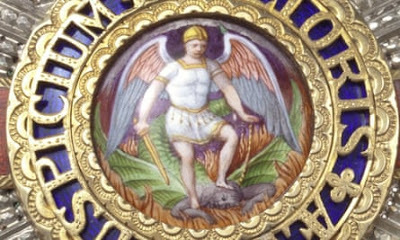
We were speaking of the demand to smash all images of Jesus. Now another clear sign of the true direction of the current winds: in the UK, a demand to delete the image on the Queen’s Medal of the Order of St. Michael and St. George. It shows St. Michael with his foot on the head of Satan. An image of the battle of good against evil.
According to the Guardian, the activists say the badge “resembles a depiction of a white angel standing on the neck of a chained black man.” Tracy Reeve, who has begun an online petition, says: “This is a highly offensive image, it is also reminiscent of the recent murder of George Floyd by the white policeman in the same manner presented here in this medal.”
Any resemblance to the killing of George Floyd is of course coincidental and in the imagination of the beholder. The award dates back to 1818.
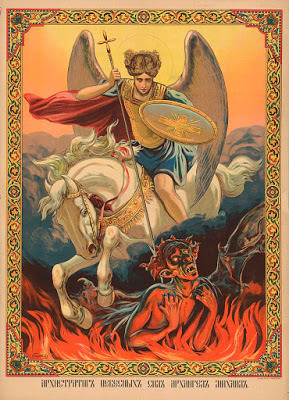 A modern Russian depiction of St. Michael
A modern Russian depiction of St. MichaelThe image of course comes from the Bible:
“There was war in the sky. Michael and his angels made war on the dragon. The dragon and his angels made war. They didn't prevail, neither was a place found for him any more in heaven. The great dragon was thrown down, the old serpent, he who is called the devil and Satan, the deceiver of the whole world. He was thrown down to the earth, and his angels were thrown down with him.”
St. Michael’s foot on the Devil’s head is a reference to Genesis:
“Yahweh God said to the serpent, ‘Because you have done this, you are cursed above all livestock, and above every animal of the field. On your belly you shall go, and you shall eat dust all the days of your life.
I will put enmity between you and the woman, and between your offspring and her offspring. He will bruise your head, and you will bruise his heel.’"
It is hard to imagine this was instead about race relations, back in Palestine in the 5th century BC.
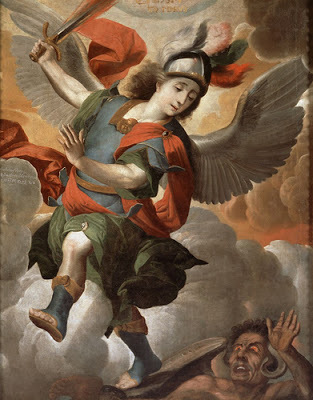 Italian depiction, 1708
Italian depiction, 1708Probably the majority of the current knights and commanders of the Order are themselves not “white”: former or present ministers from Africa, the Pacific Islands, the Caribbean, Papua New Guinea.
Sir Simon Wolley insists “the figure … is clearly a black man,” because it “has no horns or tail.”
This claim is blatantly false. The figure does have two horns and a tail. It is a serpent below the shoulders, and has wings.
How accurate is this as an ethnic description of sub-Saharan Africans? Note that Satan’s facial features are, as usually portrayed, sharp, with thin lips and a longish, thin nose. Very European.
Bumi Thomas, a black activist, claims the St. Michael of the portrait is “a white, blue-eyed figure standing on his neck.”
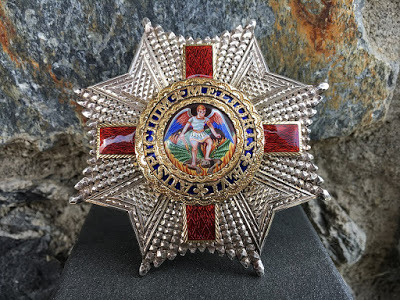 Another view of the medal.
Another view of the medal.His facial features are about as European as Satan’s, it is true. His eyes, in the image, are black; his foot is on Lucifer’s head, not his neck. And Michael too has wings. More likely, he is an angel.
The complaints, in sum, seem delusional. They seem paranoid.
It is true that the prone figure of Satan is dark-skinned, and Michael has pale skin. But, given that this is an image of good and evil, the obvious explanation is that darkness represents sin, understood as a stain, and light represents virtue. This is a standard metaphor in the Bible, and in every world culture. Mankind naturally fears darkness and favours the light.
At least, you do if you do not consider yourself on the side of sin. There is that critical passage in John:
“This is the judgment, that the light has come into the world, and men loved the darkness rather than the light; for their works were evil. For everyone who does evil hates the light, and doesn't come to the light, for fear that his works would be reproved. But he who does the truth comes to the light, that his works may be revealed, that they have been done with God."
There seems to be a Freudian inadvertent admission behind it all. Apparently the protestors spontaneously identify themselves with Satan and with evil. They do so even if they have to stretch the evidence beyond credulity to make the notion work.
They do so against the interests of blacks. What could be worse than to identify Africans with Satan and evil personified? They are doing this; not the artist.
If this claim sounds extreme, that the underlying issue here is to declare it wrong to discriminate against evil, this is not the only example. Not by a good measure. Never mind smashing statues of Jesus. “Critical theory,” the academic ideology behind much of the protest we see in the streets, does just this systematically. It loves to take traditional fables and fairy tales, and argue that it is oppressive to portray the villain as being in the wrong. This is “discriminatory.” We must instead take the side of the witches, giants, dragons, and ogres.
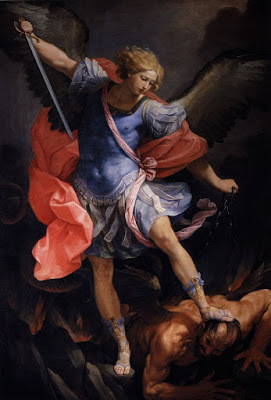
This is significant, because there is no way they can be portrayed as representatives of an oppressed class. To the contrary, the witch, giant, dragon, or ogre is always immensely powerful, and has a cache somewhere of vast riches. Jack, by contrast, is a poor boy; Rapunzel is abandoned by her poor family; and so forth. It is the privileged whom critical theory wants to support.
More significant is that the purpose of the fairy tale or fable is explicitly to teach a moral lesson. Aesop’s fables and Perrault’s collected fairy tales always conclude with a moral. When Hans Christian Anderson chose to publish his own literary tales without an explicit moral, there was considerable popular outcry.
So the real intent of making the villain the hero is to subvert the moral lesson. The villain, the witch or giant, is not human, so that he or she can be a representation of pure evil or vice.
It is evil that must not be “discriminated against.”
Understanding that this is the real problem seems to explain everything. This is why the police are the special focus of anger: whatever their flaws, the essential nature of police is to maintain the right and oppose vice. This is why statues of heroes are a special focus of anger: whatever their flaws, the essential nature of a hero is that he or she displayed some conspicuous virtue or fought some conspicuous vice.
This is why, for decades, the focus of the fight against “discrimination” was gays, and is now transsexuals. Whether or not they have indeed been discriminated against—leaving that aside for a moment—it is odd that discrimination against them has been so central to the public and the cultural agenda for so long. They are, after all, an estimated 1.6% of the population. That figure should probably be halved, since in the real world lesbianism, as opposed to male homosexuality, was never an issue. And, of course, transsexuals would be a much smaller proportion of the population.
The issue cannot, in the end, have been discrimination against gays. It was discrimination against a behavior. Homosexual sex is a behavior. If one can establish the principle that one has an inherent right to do a thing simply because one has a spontaneous urge to do it, this makes any sin a right, and prohibits calling it sinful. Nobody sins except because they have a natural urge to do it; morality consists in resisting natural urges.
There is a reason why they are called “Gay Pride” parades: lust plus pride, two sins publicly celebrated.
We seem close now to the point of perfect inversion, where the very existence of sin is denied; or rather, the only sin is admitting that there is sin.
St. Michael, pray for us.
'Od's Blog: Catholic and Clear Grit comments on the passing parade.
Published on June 25, 2020 16:06



